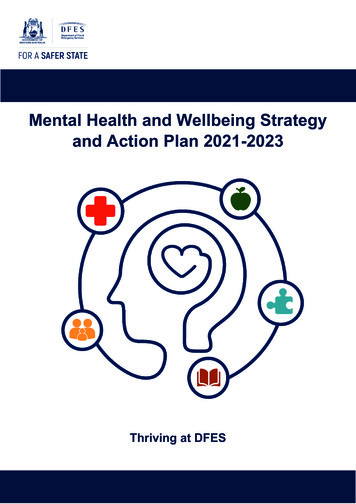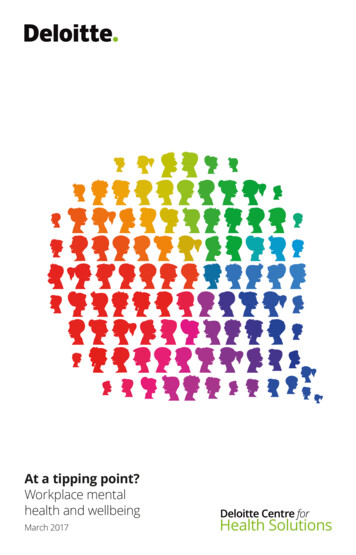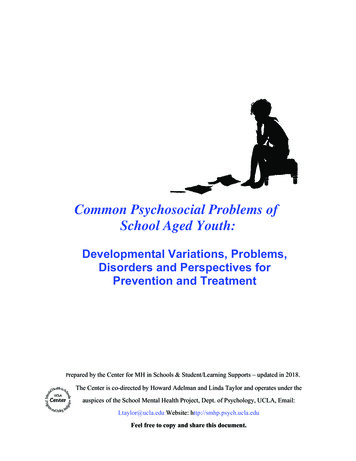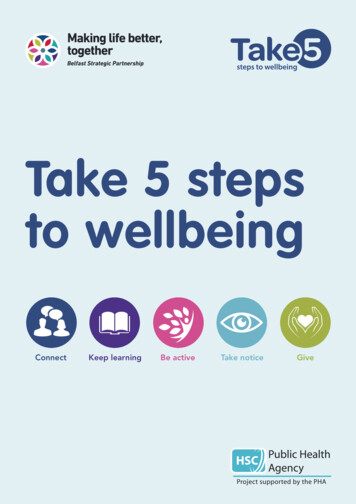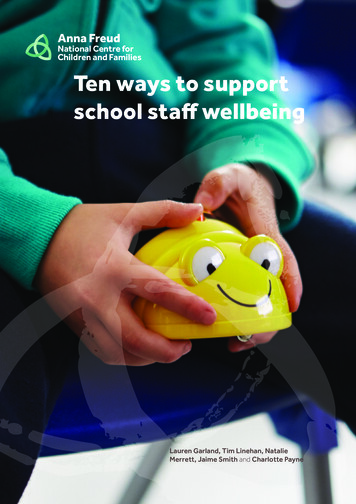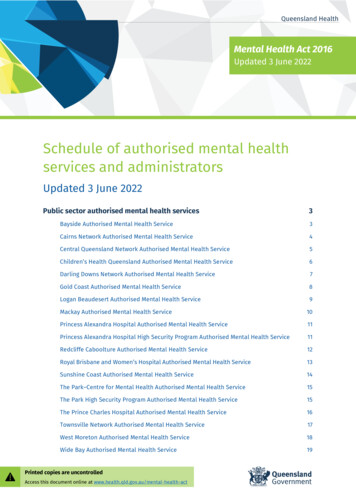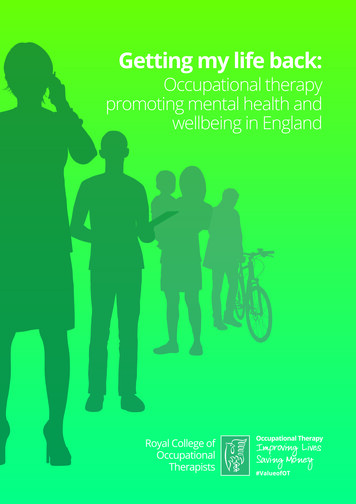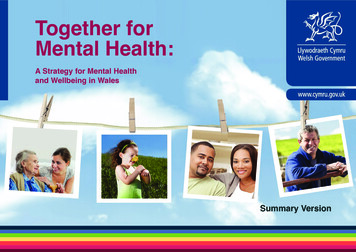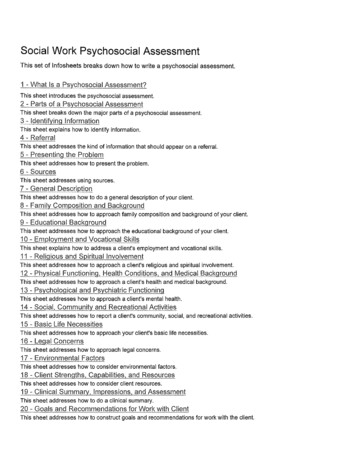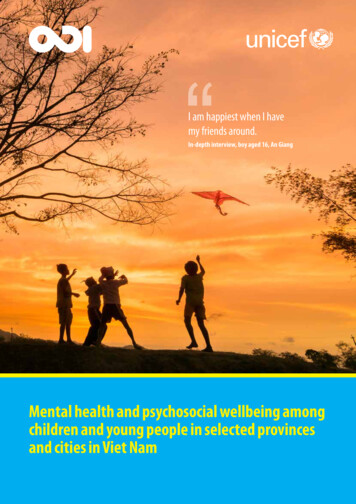
Transcription
I am happiest when I havemy friends around.In-depth interview, boy aged 16, An GiangMental health and psychosocial wellbeing amongchildren and young people in selected provincesand cities in Viet Nam
Overseas Development Institute203 Blackfriars RoadLondon SE1 8NJUNICEF Viet NamAdd: Green One UN House, 304 Kim Ma, Ba Dinh, Ha NoiTel: 44 (0) 20 7922 0300Fax: 44 (0) 20 7922 0399E-mail: info@odi.org.ukTel: ( 84 24) 3850 0100Fax: ( 84 24) 3726 5520Email: cebookwww.odi.org/twitterFollow us: www.unicef.org/vietnam www.facebook.com/unicefvietnam www.youtube.com/unicefvietnamReaders are encouraged to reproduce material from this report for their own publications, as long as they are not being soldcommercially. As copyright holder, ODI and UNICEF request due acknowledgement and a copy of the publication. For online use,we ask readers to link to the original resource on the ODI and UNICEF websites. The findings, interpretations and conclusionsexpressed in this report are those of the author(s) and do not necessarily represent the policies or views of the United NationsChildrens Fund (UNICEF) and Overseas Development Institute (ODI) .Cover photo: UN Viet Nam\2011\ShutterstockWith special thanks to Vu Thi Hai Ha, Youth Programme Officer, UNESCO Ha Noi and Mako Kato, Education Project Assistant, UNESCOHa Noi, Nguyen Nhat Linh, Education Project Officer, UNESCO Ha Noi, for their contribution to the illustrative photos in this report.
Mental health and psychosocial wellbeing amongchildren and young people in selected provinces andcities in Viet Nam
AcknowledgementsThe Study on ‘Mental health and psychosocial wellbeing of children and young people in selectedprovinces and cities in Viet Nam’ was carried out as part of a broader collaboration between UNICEF VietNam and the Ministry of Labour, Invalids and Social Affairs (MOLISA), with research and technical expertiseprovided by the Overseas and Development Institute (ODI). The Study aims to provide an overview of thesituation of mental health and psychosocial wellbeing of children and young people in Viet Nam.The Study researching team consisting of Fiona Samuels, Nicola Jones and Taveeshi Gupta from ODI and ThuyDang Bich and Le Dao Hong from the Institute for Family and Gender Studies. The researching team would liketo acknowledge support from their external peer reviewers, Bassam Abu Hamad and Martha Bragin, for thehelpful and detailed comments on early drafts. And they would also like to thank the numerous respondentsin all the study locations for providing them with time and answering many questions. The research teamwould highly appreciate the Social Protection Department of MOLISA in supporting the research includingorganization of consultations on the drafts.The Study benefited from financial and methodological support from UNICEF Viet Nam. And finally, theresearch team would like to acknowledge the great contribution from the Child Protection team of UNICEFViet Nam for their tireless efforts in reviewing, providing comments on the drafts and proof-reading the fullreport as well as briefing documents.4Mental health and psychosocial wellbeing of children and young people in selected provinces and cities in Viet Nam
AbbreviationsADHDAttention deficit hyperactivity disorderCBCPSCommunity based child protection systemDCPCDepartment of Child Protection and CareDOHDepartment of HealthDOLISADepartment of Labour, Invalids and Social AffairsFFemaleFGDFocus group discussionGCCGrand Challenges CanadaGSOGeneral Statistics OfficeHCMCHo Chi Minh CityHHWsHamlet health workersIDIsIn-depth interviewsJICAJapanese International Cooperation AgencyKIKey informantKIIKey informant interviewLMICLow- and middle-income countriesLSSLower secondary schoolMMaleMICSMultiple Indicator Cluster Survey (UNICEF)MOETMinistry of Education and TrainingMOHMinistry of HealthMOLISAMinistry of Labour, Invalids and Social AffairsPHADInstitute of Population, Health and DevelopmentPTSDPost-traumatic stress disorderRTCCDResearch and Training Centre for Community DevelopmentSAVYSurvey Assessment Vietnamese YouthSDGsSustainable Development GoalsSDQStrengths and Difficulties QuestionnaireSPCSocial Protection CentresSWCsSocial Work CentresUNICEFUnited Nations Children’s FundUSSUpper Secondary SchoolVUSTAViet Nam Union of Science and Technology AssociationsMental health and psychosocial wellbeing of children and young people in selected provinces and cities in Viet Nam5
6Mental health and psychosocial wellbeing of children and young people in selected provinces and cities in Viet NamContentsAcknowledgementsAbbreviations251. Introduction andbackgroundExecutive Summary332. Methodology41553. Magnitude and4. Risk andprevalence ofprotective factors formental health andmental health issuespsychosocial issuesand psychosocialin Viet Namdistress amongstchildren and youngpeople in Viet Nam UNICEF Viet Nam\2015\Truong Viet Hung
Mental health and psychosocial wellbeing of children and young people in selected provinces and cities in Viet Nam81971055. Mental health and6.Challenges in7. Political economyPsychosocial Careservice provisionof mental healthservice delivery systems71138. Recommendationsand psychosocialsupport in Viet NamReferences 119Annex 1: Data on suicide in Dien Bien province 124Annex 2: Background on School Psychological Consulting/Counsellingin Viet Nam 126Annex 3: Findings of Statistical Analysis of SDQ and Self-Efficacy Scale Scores 129Annex 4: Policies and legal documents related to mental health, social work andchildren 147
TablesTable 1: Respondent types and numbers by location 36Table 2: The age of children as the whole qualitative sample 36FiguresFigure 1: Demographic characteristics of the children took part in assessment (N 402) 8Mental health and psychosocial wellbeing of children and young people in selected provinces and cities in Viet Nam37
BoxesBox 1: Some definitions 27Box 2 - Key Statistical Analysis Findings of SDQ and Self-Efficacy Scale Scores 44Box 3: Reasons/causes for suicidal ideation 48Box 4: Mental health services through the government hospitals in Hanoi 83Box 5: Mental health services through the government hospitals in HCMC 84Box 6: Systemic counselling in schools (a case of Olympia School in Hanoi) 92Box 7: Shamanism and the Hmong according to Hmong Shaman 94Box 8: Limitations in policies Mental health and psychosocial wellbeing of children and young people in selected provinces and cities in Viet Nam1099
Executive SummaryIntroduction andBackgroundMental health has been recognisedas an integral part of broaderdefinitions of health (see e.g. WHO,2001), wherein mental health isnot equated simply as the absenceof mental disorder, but includessubjective wellbeing, self-efficiency,autonomy, competence, andrealization of one’s potential.Widening out the discussion to alsoinclude the notion of psychosocialwellbeing, a body of literatureacross various disciplines exploresthe causes of both mental ill-healthand psychosocial distress showingthat it is multifactorial and includesbiological, psychological and social10and environmental factors. It is thelatter group of causes i.e. the socialfactors and environmental, to whichthis study contributes. Thus a rangeof social and environmental factorsincluding rapid social change,migration, unemployment, povertyand changes in traditional values,have been recognised as beingkey drivers of mental ill-healthand psychosocial distress andparticularly amongst young people.The purpose of this study isto provide an overview of thesituation and context of mentalhealth of children and youngpeople in selected provinces andcities in Viet Nam. It does not seekto be representative of the whole ofViet Nam. Nevertheless, findings arevalid in themselves and provide animportant set of findings which willinform recommendations on howto address the challenge of mentalill-health and psychosocial distressamongst children and youngpeople, also feeding into existingnational level programmes.Four overarching researchquestions guided the study: What is the prevalence ofmental health and psychosocialproblems, including suicideamong Vietnamese children,adolescents, and youth? Which factors in the Vietnamesecontext place children,adolescents, and youth atrisk and which factors act asprotective factors for mentalMental health and psychosocial wellbeing of children and young people in selected provinces and cities in Viet Nam
and psychosocial distress at themilder end of the mental healthdisorder spectrum, also referredto as common mental disorders(CMDs), and largely to what havebeen defined internationally asinternalising/emotional problemssuch as anxiety, depression,loneliness, sadness and somaticcomplaints, all of which can havea range of negative outcomes,including suicide.To situate and present our findings,we adopt a socio-ecologicalframework, with children/youngpeople at the centre, whichexplores factors at different levelsof the social ecology – individual,family/household, school,community, institutional – andthe ways in which they interactand contribute to both drivers orrisk factors of mental health andpsychosocial well-being as well asprotective factors.health and psychosocialproblems, including suicide? What laws and policies existaround mental health andpsychosocial wellbeing in VietNam? What kind of mental health andpsychosocial service provisionsand programmes exist forchildren and youth in Viet Nam?It is important to note, and as wasreflected in the research teamcomposition, and following thefocus discussed above on socialand environmental drivers ofmental ill-health and psychosocialdistress, the study does not focuson severe mental disorders. Ratherit focuses on mental ill-healthTwo main approaches were used forthis study: a regional and nationalreview of secondary data andqualitative primary data collection.(A total of 110 interviews werecarried out, respondents includedservice providers, parents, childrenand young people). Additionally,two internationally validated scalesfor measuring wellbeing were usedwith 402 school children (aged11-14 and 15-17) : the Strengths andDifficulties Questionnaire (SDQ) andthe Self-Efficacy (SE) and ResilienceScale.Primary data collection took placein Ha Noi and Ho Chi Minh City andin the provinces of Dien Bien in thenorth and An Giang in the south;in these provinces data collectiontook place in both urban and ruralareas.Magnitude andprevalence of mentalhealth issues inViet NamFindings from the secondaryliterature. A review of the fledglingevidence base on mental healthissues in Viet Nam found that theprevalence of general mentalhealth problems in Viet Nam rangesfrom 8% to 29% for children andadolescents, with varying ratesacross provinces, by gender andby respondent and dependingon the study methodology. Arecent epidemiological survey of anationally representative populationfrom 10 of 63 provinces found thatthe overall level of child mentalhealth problems was about 12%,suggesting that more than 3 millionchildren are in need of mental healthservices. The most common typesof mental health problems amongchildren studied in Viet Nam arethose of internalizing (such asanxiety, depression, loneliness)and externalising problems (suchas hyperactivity and attentiondeficit issues).While there is increasing concernwith the rates of suicide amongyoung people in Viet Nam, Viet Nam’sreported suicide rate is remarkablylow compared to global estimates.In a 90-country study, among alladolescent deaths the suicide ratewas 9.1% (Wasserman et al., 2005),while in Viet Nam it was only 2.3%respectively (Blum et al., 2012).Substance abuse, which includesusing drugs, abusing alcohol, andsmoking, can also be a driver or arisk factor for mental ill-health andpsychosocial distress; tobacco useespecially was common amongVietnamese adolescent males(almost 40%). Though co-morbidityis not a risk factor by itself, theliterature indicates that one form ofmental illness may act as a risk factorfor another. Moreover, concernsMental health and psychosocial wellbeing of children and young people in selected provinces and cities in Viet Nam11
12Mental health and psychosocial wellbeing of children and young people in selected provinces and cities in Viet Namare emerging that these mentalissues are indicative of additionalpsychosocial challenges below thesurface that may require furtherstudy going forward.Findings from the qualitativeprimary data collection. Despitethe relatively low incidence ofmental health problems reported inthe secondary data there is a generalperception amongst all studyrespondents that both psychosocialand mental health problems areboth widespread and increasing,with some saying they felt thatchildren face a greater mental healthburden than adults and that differentage groups face different kindsof problems. However, they alsomentioned that challenges remain interms of estimating more preciselythese numbers and particularly inrelation to children.thought that stigma towards peoplefacing mental health challenges wasdeclining, it was also mentionedthat while people might notoutwardly stigmatize, they do soinwardly and/or show indifference,and it was suggested that as aresult of prevailing stigmas, peopleare reluctant to access services.Emerging strongly from manynarratives was the fact that mentalhealth issues are not well understoodwith this lack of understandingalso leading to fear of those withmental ill-health. Narratives around‘social evils’ were heard amongststudy respondents, often linked todiscussions about substance abuseand addiction to internet games andgambling, which in turn can alsohave implications for mental healthand psychosocial wellbeing as wellas other anti-social behaviour suchas stealing.Respondents spoke about peoplewith mental health difficulties invarious ways: they were seen to be‘unknowledgeable’, ‘negative’, or‘different.’ Similarly, respondentsbelieved that ‘their way of thinkingis different’, they have some kindof ‘disease’, are ‘an exception’, orare ‘unstable’. While respondentsIn keeping with the literatureon mental health, narratives arepresented based on the followingbroad areas: psychological state ofparticipants, cognitive disorders,emotional disorders, somaticcomplaints, behavioural disordersand substance abuse. Clearly, thesedisorders and complaints are not UNICEF Viet Nam\2017\Truong Viet Hungmutually inclusive, with manycoexisting and one often resultingin another. Similarly, manifestationscan also be risk factors, also furtherdriving mental ill-health andpsychosocial distress. Thus in termsof the psychological state of studyparticipants, two main feelingswere expressed: on the one hand,optimism about the future, and onthe other hand sadness and worry.Children of all ages, particularlythe younger age categories, hadgreat optimism and aspirations forthe future. Worries, sadness andgeneral pessimism was expressedmore frequently by older children.The reasons for worry and sadnessranged from parents fighting,a family member being unwell,performance in school, fear ofdropping out of school, uncertaintyabout the future and early marriage.The older age group, particularly girlswho had dropped out of school andwho were already married, worriedabout their financial security andthat of their child as well the maritaldiscord they were facing with theirhusbands. Symptoms of this sadnessand worry include stress, which ledto skipping meals, headaches andanger.
Mental health and psychosocial wellbeing of children and young people in selected provinces and cities in Viet NamEmotional disorders, underwhich depression and suicide fall,were prevalent amongst studyrespondents. Generally, girls wereperceived to be more susceptibleto emotional problems than boys.The way children and young peoplespoke about and perceived suicideappeared to vary according to ageand gender: while the younger agegroup (11-14) had heard of ‘many’people who had attempted suicide,by the time they got to the next agegroup (15-17) there were several casesof suicidal ideation and amongstthe older age groups, and somerespondents also reported havingtried to commit suicide themselves.There was a general perception thatit was mostly young people andgirls who committed or who tried tocommit suicide, and the availabilityof poisonous la ngon or ‘heartbreak’leaves in Dien Bien makes suiciderelatively easy. Reasons for suicidalideation and attempted suicidefor males and females includefailure of romantic relationships,marital discord, problems at school,problems at home, and reluctanceto share feelings. For men, additionalreasons include not being able to liveup to expected masculine attributesand behaviour, including the abilityto maintain the family/household.Somatic complaints - headaches,loss of appetite, poor sleep andnightmares - were mentioned bymany respondents. Reasons forthese were largely related to thestress associated with academicpressure, but also, particularly forgirls, as a result of stress from havingto do housework. Finally, substanceabuse – alcohol, smoking anddrugs - was also mentioned by manyrespondents in our study and waslargely associated with boys, youngmen and husbands. According torespondents, substance abuse resultsfrom peer pressure to ‘drink to forgettheir troubles’ or from sadness andgeneral social pressure. Substanceabuse can also lead to violenceand early marriage of drug addicts’children.Preliminary analyses of the SDQ andSE Resilience Scales found that interms of mental health problems,of the four domains of behaviouraland emotional problems, this studyfound that the rate of childrenscoring ‘Abnormal’ in the Emotionalproblems Scale is more than twiceas high as those in other Scales,which suggests that emotionalproblems are what children strugglewith the most during adolescence.The rate of children having conductproblems in this study also appearsto be quite high; the most commonsymptoms include getting angryand losing temper easily, and lackof self-control. The majority ofthe children in the survey sampleshowed problems or symptomsof hyperactivity. Very few of thechildren were confident thatthey possessed good attention,judgement and ability to analyseand complete tasks effectively. Interms of children’s self-efficacyand perceived self-efficacy,analyses revealed a relatively positiveperception of self-efficacy amongthe children in the sample, both inunexpected/unforeseen situationsand especially when activelyfacing difficult problems, althoughthe number of children havinggood self-efficacy in coping withunexpected events is a bit lower.Particularly, in the face of difficultiesand challenges, many of the childrenbelieved in their coping abilities.They could keep calm to solve theproblems, and were confident intheir own efforts and abilities tofocus on pursuing and achievingtheir goals.It is important to note thatoverall, while the global literaturehighlights the importance ofpoverty, adversity, migrationand family separation as causesof mental ill-being, these are notstrong themes in the secondaryliterature on Viet Nam. The existing13literature on mental health issuesin Viet Nam tends to be highlymedicalized, and thus we try to drawmore attention to these socioeconomic factors in our analysis ofthe primary data which we discussespecially at the household level(see below). There are also likely tobe a range of other factors whichinfluence the mental health andpsychosocial wellbeing of childrenand young people in Viet Namincluding factors such as trafficking,sexual abuse and violence. Theseissues were not explored in theliterature review since these aretopics in themselves and worthy ofseparate studies. The primary datacollection also did not focus directlyon these issues, though some ofthese issues did emerge indirectlye.g. through stories of isolated youngmothers being at the mercy of theirhusbands.Risk and protectivefactors for mentalhealth issuesThe report explores both risk andprotective factors (including copingstrategies) of children and youngpeople at four levels: individual,household, school and community. Inthe following sections we focus on theprimary data; for further findings fromthe literature review please see the fullreport or the literature review report(Samuels et al, 2018).Individual levelRisk factors. Three main individualrisk factors emerged for youngpeople, with some age and genderspecific variations. First, emotionalisolation / self-isolation wasan important source of risk, withchildren often reporting choosingnot to share their feelings withanyone, often because they wantedto protect their parents fromworrying. For older adolescents,especially girls, feelings of social
14Mental health and psychosocial wellbeing of children and young people in selected provinces and cities in Viet Namisolation result from early marriage.Other girls in this age group alsoattributed their social isolation todropping out of school againsttheir choice and/or to the burdenof domestic responsibilities. Asecond driver of psychologicalill-being is linked to access tomodern technology and the risksof addictive online behaviours,with this access posing a threat towellbeing since children tend to“use it too much”. Boys tend to spendmore time online, playing gamesin the internet shops and theirsadness is attributed to losing gamesonline. Over time, online gamingalso appears to have negativespill-over effects on scholasticachievement. Respondents statedthat boys are more likely to playcomputer games than girls, but girlsare more at risk from cyber bullyingand stalking. A third key risk factorrelates to negative perceptions ofadolescent physical appearance.These concerns begin in earlyadolescence, especially among girls,who are anxious about menstruationor who are perceived to beoverweight. Other physical concernsrevolved around being too short,which leads to teasing, name callingand discrimination in school sportsactivities.Coping strategies. A range ofboth positive and negative copingstrategies was identified for dealingwith mental and psychosocial illbeing. The first key protective factormentioned was active participationin leisure activities (e.g. sports,martial arts, reading, watchingmovies, joining school clubs or trips,learning through the internet). Asecond critical protective factorwas having or being part of goodsocial networks. The importanceof having friends was noted acrossall interviews, irrespective of gender.There were also several examples ofchildren having good role modelsto follow, although this was morecommonly cited by boys. These aregenerally adults they know — olderbrothers, teachers, uncles — whohave qualities that they admire andwho have been good to them.Negative coping strategiesincluded crying alone, substanceabuse (especially drinking alcohol),vandalism and suicidal ideation— most commonly mentioned inDien Bien and in relation to pressuresaround school drop-out and earlymarriage. All of which can in turnfurther fuel mental ill-health andpsychosocial distress.Household levelDrivers/risk factors. Three broadsets of factors at household levelwere identified: overly restrictivefamily rules (especially withregard to scholastic achievementand marriage), poor or declininghousehold socio-economic status,and intra-household tensions. Interms of family rules, youngerchildren emphasised that they facedhigh expectations from parentsin terms of carrying out domesticchores and caring for youngersiblings and were afraid of being‘scolded’ by parents for not doingthem adequately. Similarly, childrenare also fearful of parents criticisingthem for poor marks at school, andthere have been some instancesin which scolding for academicperformance has led to suicideattempts. For mid-adolescents (i.e.around 14-16 years of age), whenyoung people are increasingly tryingto define an independent identity,parental “control” was seen as akey source of stress, with childrenreporting that their parents do notallow them to go out with theirfriends, disapprove of romanticrelationships, monitor their cellphone use, and make them dochores around the house.Poor or declining householdsocioeconomic status, can limitopportunities for socialisingwith peers, limit their scholasticachievement by leaving themwith less time to do schoolworkand fewer means for extra-tuitionclasses, or force them to drop outof school altogether. This leads tohigh levels of stress for children, whoare not able to achieve their futureaspirations. Parental migration,also due to financial reasons, canalso have a negative effect onchildren’s mental health, withchildren left behind facing sadnessand depression. In addition, earlymarriage, often associated for girlswith school-leaving, was also foundto lead to sadness and depression.Household tensions arise from anumber of sources including: familypressure on children to excel inschool, a general feeling that parentsdon’t understand children, maritalconflicts (which often spill overonto children), divorce, domesticviolence from husbands, and lack ofcommunication between parentsand children, often as a result ofchanging family structures andthe pressures facing parents in acompetitive labour market leading tothem often neglecting their children.Protective factors and responses.Two sets of protective factorswere identified: relatively betteroff household socioeconomicstatus mitigated some sourcesof stress experienced by youngpeople, thus it was mentioned thatchildren in better-off householdswere more likely to completetwelfth grade. And emotionallyhealthy family relationships orfamily connectedness were alsoa key positive factor in mitigatingpsychosocial stress and ill-being —children felt loved the most by theirparents and grandparents, and felthappy when they were able to sharetheir feelings and concerns withthem.School-level driversRisk factors. Three main sets of riskfactors were identified: academicstress, inadequate support and/
Mental health and psychosocial wellbeing of children and young people in selected provinces and cities in Viet Namor shortcomings of the schoolenvironment, and challengesfaced in romantic relationships.Respondents agreed that theacademic pressure they face is oneof their main worries – concernsrelated largely to performance,with children placing very highexpectations on themselves to dowell, which was further exacerbatedwhen comparing themselves withtheir peers and by pressure fromtheir families to do well. Whilethe secondary literature has paidconsiderable attention to theproblem of after-school tuitionputting additional pressures onadolescents (e.g., see Ko and Xing,2009), in our sample, this did notemerge as a significant concern,likely due to very high levels ofpoverty and marginalization.Shortcomings within the schoolenvironment were manifested byhigh levels of bullying and peerconflict. Being away from familyand in boarding school, is an addedstressor, as is the lack of leisureactivities and often unsupportiveteachers. Romantic relationships,which often start in the schoolenvironment, were often associatedwith stress since, on the one hand,they have to remain hidden fromparents and teachers who wouldforbid them and , on the other hand,break-ups and unrequited lovelead to sadness, depression andsometimes even suicidal ideation orattempts.Responses and coping strategies.A number of schools, largely inurban areas, have psychologicalcounselling units, and girls accessthem more than boys. Shortcomingsof these units ranged from studentsnot knowing about them andtherefore rarely accessing them,to variability in the capacities ofcounsellors, to the location ofthe unit in a public space with noprivacy, to the fact that there aresometimes only male counsellorswith whom girls may be reluctant toshare their feelings. The life-skills15 UNICEF Viet Nam\2017\Colorista\Hoang Hieptraining and citizen educationthat children receive in school helpsthem deal with stress, as do clubs,other extra-curricular activities andthe internet. Teachers are also animportant part of students’ copingrepertoires, particularly in relation tostudying and sometimes with familyrelated issues.Community levelRisk factors: Three main categorieswere identified: easy access toharmful substances; lack of accessto economic opportunities; andharmful norms. Easy access toharmful substances was particularlyprevalent in Dien Bien province,where access to drugs and topoisonous (la ngon) leaves waswidespread. Alcohol abuse was alsoprevalent. Reasons for abuse rangefrom people wanting to use them,to being tempted by their friends,to having cheap and easy access tosubstances. Since opportunities (interms of employment/future jobsand leisure activities) in rural areasare limited, and limited knowledge
16Mental health and psychosocial wellbeing of children and young people in selected provinces and cities in Viet Nam UNICEF Viet Nam\2017\Truong Viet Hungof vocational options, this alsocauses potential stress for childrenand young people, with narrativesin urban areas highlighting higherlevel career aspirations of childrenand young people. Harmful normsappear to be more prevalent in ruralareas and largely in the impoverishednorthern highlands. These includenorms around early marriage forgirls - usually also resulting in a girlleaving school at an early age – whata girl should do with her life, how sheshould behave and look/dress andthe domestic roles that she needsto take on. All of these can affectthe mental health and psychosocialwellbeing of girls.Protective factors and coping.Where there are opportunities orservices focusing on mental healthand psychosocial wellbeing, thesehave a positive effect on childrenand young people. Respondentsalso note the importance of holdingpositive attitudes and beliefs,many of which can be taught inschools.Mental health service deliveryThe provision of mental healthservices falls within the remit o
framework, with children/young people at the centre, which explores factors at different levels of the social ecology - individual, family/household, school, community, institutional - and the ways in which they interact and contribute to both drivers or risk factors of mental health and psychosocial well-being as well as protective factors.
